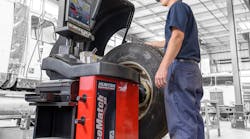When it comes to machine wheel balancers, fleets have the option to spin balance wheels on the vehicle or off.
Off-the-vehicle balancing requires a technician to dismount the wheel and transport it to a wheel balancer. The balance machine spins the wheel to determine the heavy spot, showing the technician where to place a wheel weight.
With on-the-vehicle balancing, the wheel doesn’t leave the truck or trailer. In addition to balancing the tire, it balances the hub and the drum in relation to the truck’s suspension.
“The best benefit for on-the-vehicle [balancing] is that you’re balancing everything from the hub, drum, and on out, so it takes a lot more of the imbalance out and it does it all as one unit,” says Howard Williams, corporate technical sales specialist at Bee Line Company, an on-truck tire balancing manufacturer.
Bee Line’s Smart Balancer II is an on-the-vehicle wheel balancing system that uses a touchscreen to illustrate the location and amount of weight to be added to the wheel.
“We like to [balance] on the vehicle because we like to take care of the whole product,” Williams says. “We like to make sure it’s all balanced and not just some of it, especially if it’s an older truck. They may have the [original] drums on there and it helps take care of some of that imbalance.”
Greg Meyer, product manager of wheel balancers at Hunter Engineering, believes on-the-vehicle balancing is more dangerous.
“You have this big, powerful motor spinning the assembly up to scary speed when [the technician] is right there,” he says.
Hunter Engineering’s ForceMatch HD Wheel Balancer features SmartWeight technology which eliminates the need to select the balance mode and ensures proper centering, reducing setup errors and service time.
When it comes to balancing on or off the vehicle, it’s a matter of preference. Both can address static and dynamic imbalance issues, and both can help prevent vibration and irregular tire wear.
“When possible, off-the-vehicle tire and wheel assembly balancing is preferred,” says Phil Mosier, manager of commercial tire development at Cooper Tires. “But there is still a place for on-vehicle balancing. If a tire or wheel assembly is balanced and after installation a vibration still exists, the fleet may balance the assembly on-the-vehicle in an attempt to balance the whole wheel-end assembly.”




